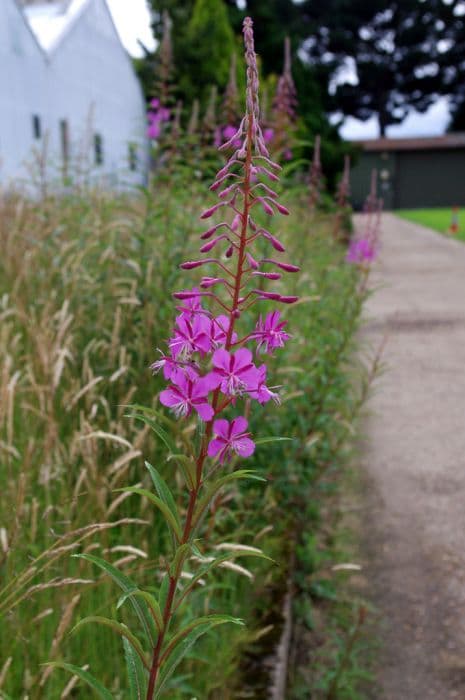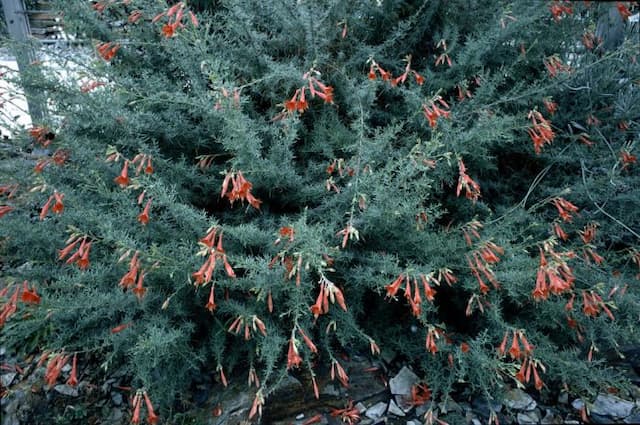Fuchsia Fuchsia 'York Manor'

ABOUT
Fuchsia 'York Manor' is a captivating plant with a rather graceful and ornamental appearance. It stands out with its striking flowers, which dangle like delicate lanterns. These blossoms are typically bicolor, featuring a bold pairing of a deep purple or pink hue with a contrasting bright pink or almost white petal edges that flare out elegantly. This gives the flowers a layered look, with the outer parts often curling back to reveal the inner beauty. The foliage of 'York Manor' forms a lush backdrop to the flowers, comprised of deep green leaves that have a subtle glossy finish. The leaves are oval or slightly elongated with a soft texture and may have a slight serration along the edges, giving a gentle, tactile quality to the plant. Adding to its charm, the stems on which the flowers and leaves grow may be somewhat trailing or with a slight arch, giving the plant a cascading or weeping profile. This makes it particularly attractive when grown in hanging baskets or elevated planters, where the full extent of its flowing nature can be appreciated. It's a plant that exudes a classic elegance and provides an eye-catching burst of color to any environment where it is displayed. In essence, Fuchsia 'York Manor' is a graceful plant known for its vibrant and pendulous flowers, set against a backdrop of lush green foliage, creating a delightful contrast and a visually engaging display of natural beauty.
About this plant
 Names
NamesFamily
Onagraceae
Synonyms
Lady's Eardrops, Fuchsia
Common names
Fuchsia 'York Manor'.
 Toxicity
ToxicityTo humans
Fuchsia 'York Manor', commonly known as Fuchsia, is generally considered to be non-toxic to humans. It does not contain any known toxic principles, and there are no common symptoms associated with ingestion of this plant. Accidental consumption is not expected to lead to any significant health issues, but as with any non-food plant, individual sensitivities can vary, and it is always best to avoid eating ornamental plants. If any unusual symptoms do occur after ingesting any part of a Fuchsia plant, it is advisable to consult a medical professional.
To pets
Fuchsia, which is the common name for Fuchsia 'York Manor', is also considered to be non-toxic to pets, including cats and dogs. It does not contain substances known to cause poisoning in these animals, so ingestion of this plant should not result in any serious health complications. However, gastrointestinal irritation is possible if a pet consumes a large amount of any non-food item, including ornamental plants. If a pet displays signs of distress after consuming Fuchsia, such as vomiting or diarrhea, it is recommended to consult a veterinarian.
 Characteristics
CharacteristicsLife cycle
Perennials
Foliage type
Deciduous
Color of leaves
Green
Flower color
Mixed
Height
1-2 feet (30-60 cm)
Spread
1-2 feet (30-60 cm)
Plant type
Shrub
Hardiness zones
9
Native area
Central and South America
Benefits
 General Benefits
General Benefits- Aesthetic Value: Fuchsia plants, commonly known as Fuchsias, have beautiful, unique flowers often used to enhance the beauty of gardens and landscapes.
- Attracts Pollinators: They are known to attract hummingbirds and beneficial insects which helps in pollination.
- Versatility: Fuchsias are versatile plants that can be grown in hanging baskets, containers, or borders, fitting into various garden designs.
- Shade Tolerance: They can thrive in partly shaded locations, which makes them suitable for gardens with limited sunlight.
- Prolonged Blooming: Fuchsias have a long flowering season, from spring to fall, providing long-lasting color to a garden.
- Ease of Propagation: Fuchsias can be easily propagated through cuttings, making it simple for gardeners to create more plants.
 Medical Properties
Medical PropertiesThis plant is not used for medical purposes.
 Air-purifying Qualities
Air-purifying QualitiesThis plant is not specifically known for air purifying qualities.
 Other Uses
Other Uses- Fuchsia can be utilized in fairy gardens due to its delicate, pendant-like blooms which add a magical touch to miniature landscapes.
- Dye can be extracted from the flowers of Fuchsia for use in textile coloring, providing a natural alternative to synthetic dyes.
- The nectar-rich flowers can be used to attract and sustain pollinators like hummingbirds and butterflies in a wildlife-friendly garden.
- Petals of Fuchsia can be incorporated into potpourri mixes to lend color and a subtle fragrance to the blend.
- Pressed Fuchsia flowers are perfect for making botanical art, bookmarks, or decorative features in handmade paper.
- With their graceful form, Fuchsia flowers can add aesthetic value to water features as floating decorations.
- Living Fuchsia plants can be employed as natural privacy screens or living curtains when grown in hanging baskets.
- Fuchsias can be used in photography to teach macro photography techniques, due to their intricate and vibrant flowers.
- Fuchsia blossoms can be used in ice cubes to add an elegant and colorful touch to drinks at garden parties or celebrations.
- When dried, Fuchsia flowers may serve as a natural confetti for weddings or other festive events, offering an eco-friendly alternative to plastic confetti.
Interesting Facts
 Feng Shui
Feng ShuiThe Fuchsia is not used in Feng Shui practice.
 Zodiac Sign Compitability
Zodiac Sign CompitabilityThe Fuchsia is not used in astrology practice.
 Plant Symbolism
Plant Symbolism- Confiding Love: Fuchsia flowers often symbolize confiding love. The pendulous blooms can be seen as a gentle and trusting way of leaning towards someone, resembling the act of confiding in a loved one.
- Good Taste: The elegant shape and vibrant colors of the Fuchsia flower can represent good taste and sophistication, both in aesthetics and in character.
- Amiability: Fuchsia's graceful appearance is commonly associated with amiability and warmth, suggesting a kind and welcoming presence.
- Overflowing Abundance: With its plethora of blossoms, Fuchsia can symbolize abundance and overflowing generosity, much like the copious flowers that adorn the plant throughout its blooming season.
 Water
WaterFuchsias, including 'York Manor', require consistent moisture and should be watered whenever the top inch of soil feels dry to the touch; in many climates, this might mean watering every couple of days during the height of the growing season. It is critical to water them deeply, providing enough water to saturate the root zone. For a potted Fuchsia, this could be around 16-24 ounces of water for a medium-sized pot, depending on the weather conditions and the size of the plant. During hot spells, plants may need water daily, while in cooler periods or overcast weather, the frequency may be reduced. Always ensure that pots have adequate drainage to prevent waterlogging, which can cause root rot.
 Light
LightFuchsias, such as 'York Manor', thrive best in bright, indirect light with protection from the hot afternoon sun. An ideal spot would be where they can receive morning sunlight and then dappled or filtered shade in the afternoon. East or north-facing patios or windows are good locations, as they avoid the intense heat of the day which can scorch the delicate leaves and flowers.
 Temperature
TemperatureFuchsias like 'York Manor' prefer cooler temperatures and generally thrive in a range between 55-75°F. They can survive temporarily outside of this range, but prolonged exposure to temperatures below 50°F or above 80°F can be detrimental to the plant. The ideal temperature for robust growth and flowering is on the cooler side of this spectrum, especially during night-time.
 Pruning
PruningPruning Fuchsias like 'York Manor' is essential for maintaining a bushy, compact shape, encouraging new growth, and promoting more flowers. Lightly prune your Fuchsia in the spring to remove any dead or weak branches and to shape the plant. More substantial pruning should be done after the blooming period ends in late summer or early fall. Regular pinching of the tips of the stems throughout the growing season will also enhance the plant's fullness and flowering.
 Cleaning
CleaningAs needed
 Soil
SoilThe best soil mix for Fuchsia 'York Manor', commonly known as Fuchsia, is a well-draining, fertile potting mix with a high content of organic matter like peat or compost. The soil pH should be slightly acidic to neutral, ideally between 6.0 and 7.0.
 Repotting
RepottingFuchsia 'York Manor', or Fuchsia, should be repotted every 2 to 3 years, or when the plant becomes root-bound. Repotting is best done in late winter or early spring before the onset of new growth.
 Humidity & Misting
Humidity & MistingFuchsia 'York Manor', commonly referred to as Fuchsia, thrives in high humidity levels. Keeping the humidity around 60-70% is ideal for this plant.
 Suitable locations
Suitable locationsIndoor
Place in bright, indirect light and maintain high humidity.
Outdoor
Protect from strong sun, plant in dappled shade, keep moist.
Hardiness zone
9-11 USDA
 Life cycle
Life cycleThe Fuchsia 'York Manor' starts its life cycle when seeds germinate in a moist, warm environment, developing into seedlings with primary leaves. As the plant grows, it enters the vegetative stage, producing bushy growth and characteristic fuchsia leaves. Following the vegetative stage, the plant reaches maturity and enters the flowering stage, where it produces its distinctive hanging flowers, usually during the spring and summer months. After pollination, which is often assisted by hummingbirds or other pollinators, the flowers develop into oval-shaped berries that contain numerous tiny seeds. When conditions are favorable, these seeds will disperse and can germinate to begin the cycle anew. During winter or unfavorable periods, the plant may undergo a dormancy stage, with reduced growth activity, which allows it to survive until favorable conditions return.
 Propogation
PropogationPropogation time
Spring-Early Summer
The Fuchsia 'York Manor', commonly known as hardy fuchsia, is best propagated through softwood cuttings, a method that is most successful when done in spring to early summer when the plant's growth is most vigorous. To propagate by this method, a gardener should select healthy, non-flowering shoots and cut a 2-4 inch (5-10 cm) length just below a leaf joint. The lower leaves are removed, and the cut end may be dipped in rooting hormone powder to encourage root development. The cutting is then placed in a pot filled with a mixture of peat and perlite or a similarly well-draining soilless medium, ensuring that at least two leaf nodes are buried where roots will form. The pot should be kept under partially shaded conditions, maintaining high humidity by covering it with a plastic bag or placing it in a propagator, and kept moist but not waterlogged until roots have developed, which typically takes several weeks.









